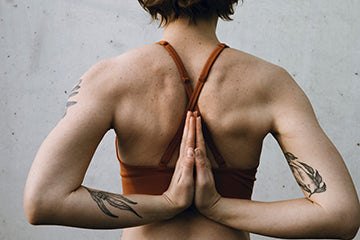
How to Clean and Maintain Your Yoga Mat the Right Way

How to Clean and Maintain Your Yoga Mat the Right Way
Introduction
Cleaning your yoga mat is an essential part of your yoga practice. A clean mat will not only last longer, but it also ensures a hygienic surface to practice on. Practicing yoga on an unclean mat can lead to skin infections, allergies, and respiratory problems. Yoga mats, like any other absorbent material, can harbor bacteria. When you're sweating on your mat, you're creating an ideal environment for bacteria to thrive. Even the oils from your hands and feet contribute to bacteria growth.
These bacteria not only impact the cleanliness of your mat but also pose health risks, making it essential to maintain a clean practice space. Regular cleaning can help mitigate these risks and ensure that your yoga practice remains both safe and enjoyable.
In this blog post, we will outline the essential steps for cleaning and maintaining your yoga mat the right way.
Why Cleaning and Maintaining Your Yoga Mat is Important
Cleaning and maintaining your yoga mat is essential to ensure that it lasts longer and remains hygienic. When you practice yoga, sweat, dirt, and bacteria accumulate on your mat, making it a breeding ground for germs. Regular cleaning helps to keep your mat free from these harmful substances, ensuring a clean practice surface.
Why Clean a New Yoga Mat Before Use?
When you unpack a brand-new yoga mat, it might look pristine and ready to use. However, taking the time to clean it before your first practice is a crucial step you shouldn't skip.
Remove Slippery Residue
Many yoga mats come with a slick finish resulting from the manufacturing process. This residue can create an unexpectedly slippery surface. Without a proper initial cleaning, this can lead to a lack of stability during poses, as the oils and sweat from your hands and feet may amplify the slipperiness.
Enhance Your Practice Experience
A clean mat not only boosts your performance by providing the necessary grip but also contributes to a safer practice. By eliminating any residues, you ensure a secure foundation, allowing you to focus on your poses without the worry of slipping.
Maintain Durability and Hygiene
Regular upkeep begins with the first wash. By cleaning your mat before the initial use, you lay the groundwork for a longer-lasting and more hygienic practice tool. This proactive approach means less wear and tear over time, preserving the mat's quality.
By starting with a clean mat, you prepare yourself for an enhanced, safe, and effective yoga experience.
The Benefits of a Clean Mat
A clean yoga mat not only provides a safe and hygienic surface to practice on, but it also has other benefits. A clean mat offers better traction, allowing you to hold poses better, and reduces the risk of injuries.
When your mat is dirty, its surface becomes less grippy, making it difficult to maintain stability during your practice. This can lead to sliding around, which not only disrupts your focus but could also cause slipping or even falling. The fear of sliding can prevent you from fully engaging in your asanas, as you might subconsciously hold back to avoid losing your balance.
By keeping your mat clean, you ensure a stable, reliable surface that enhances your practice, allowing you to concentrate on form and technique without distraction.
It also improves the overall appearance of your mat, making it more inviting to practice on.
If you practice a particularly sweaty style of yoga, it's crucial to clean your mat regularly to maintain hygiene and longevity. Ideally, you should give your mat a quick cleanse after each session to remove sweat and bacteria.
Here's a simple routine to follow:
-
After Every Practice: Use a gentle yoga mat spray or a homemade solution of water and a few drops of essential oil. Wipe the surface clean with a soft cloth.
-
Weekly Deep Clean: At least once a week, give your mat a more thorough wash. You can do this by using a mixture of water and mild soap. Rinse with water and hang it dry to ensure it’s ready for your next session.
By keeping up with this cleaning regimen, you'll ensure your mat stays fresh and ready for practice, fostering both a healthier environment and a more pleasant yoga experience.
How to Make Your Yoga Mat Less Slippery
Struggling to maintain your grip during your yoga practice? A slippery mat can be more than just frustrating—it can affect your focus and form. Here’s how you can ensure solid footing and a more satisfying yoga session.
1. Clean Your Mat Regularly
New mats often come with a residue left by the manufacturing process, which can contribute to slipperiness. Here's how to tackle it:
- Initial Wash: Before using your mat for the first time, give it a good clean. Use a solution of mild soap and warm water. Avoid harsh chemical cleaners.
- Routine Maintenance: After each practice, wipe down your mat with a natural mat spray or a cloth dampened with a bit of water and a few drops of essential oil, like tea tree, which has antimicrobial properties.
2. Break It In
Just like a new pair of shoes, yoga mats need to be broken in. Roll your mat out in the sun occasionally. The sunlight can help remove some of the slick surface and enhance its grip.
3. Use a Towel
If you sweat a lot during practice, consider using a yoga towel. These towels are specially designed to increase grip as they become damp. Spread it over your mat for a slip-resistant surface, especially in hot yoga classes.
4. Choose the Right Mat
When purchasing a new mat, consider materials that inherently offer better grip, like natural rubber or cork. Some brands are known for their superior grip technology, which can be a worthwhile investment if you frequently find yourself slipping.
5. Chalk Up
If your hands are still slipping, you might find relief using a yoga-specific chalk or grip-enhancing cream. These products can help absorb moisture and improve traction.
By following these steps, you can create a safer, more effective environment for your practice and ensure that your focus stays where it belongs—on your breath and balance, not on your slipping hands and feet.
How Often Should You Clean Your Yoga Mat for a Quieter Style of Yoga?
For those who enjoy a gentler, more meditative form of yoga, such as Hatha, the frequency of cleaning your mat can differ from more vigorous practices. Generally, it's not necessary to clean your mat after every session due to the lower intensity and sweat factor.
Aim for a Weekly Clean:
- Wiping down your mat once a week is usually sufficient to maintain hygiene and freshness.
Of course, always use a mild cleaner to prevent wear and tear, and ensure it’s completely dry before rolling it up to prevent odors or mildew. Adjust this routine as needed based on personal preference or how often you practice.
By keeping this simple cleaning schedule, your mat will stay inviting and ready for each peaceful session.
Understanding the Impact of Manufacturing on Your New Yoga Mat
When stepping onto a fresh-from-the-package yoga mat, you might be surprised to feel it’s not as grippy as expected. This slickness is often the result of the manufacturing process. During production, many yoga mats are coated with a thin layer to protect the material and give it that new look.
Why Is This Coating a Problem?
-
Slippery Surface: The protective layer can lead to a slippery surface, especially when combined with the natural oils and sweat from your body. This can make your practice more challenging and potentially unsafe.
-
Initial Cleaning: Before using your mat for the first time, it’s crucial to remove this residue to enhance traction and ensure safety during poses.
How to Prepare Your Mat
-
Gentle Cleaning: Wipe down your new mat with a solution of water and mild soap. This simple step can effectively remove the slick coating.
-
Regular Maintenance: Cleaning your mat regularly, even after the initial scrub, will help maintain its grip and prolong its lifespan.
By taking these preparatory steps, you'll not only enhance your practice but also ensure that your new yoga mat is truly ready for use.
The Benefits of Bringing Your Own Yoga Mat to the Studio
Taking your own yoga mat to the studio can offer several advantages beyond just convenience. Here’s why you might want to consider it:
-
Hygiene and Cleanliness: Utilizing a mat that isn't shared ensures a clean surface every time you practice, free from the sweat and bacteria that might linger on communal mats.
-
Personal Comfort and Familiarity: Having your own mat means you’re always practicing on a surface that you find comfortable. This familiarity can enhance your focus and stability during sessions.
-
Enhanced Performance: Personal mats are chosen for their grip, thickness, and material that suit your individual needs, allowing for optimal performance. Many find that investing in high-quality brands like Liforme or Manduka can make a significant difference in their practice.
-
Injury Prevention: A well-maintained, personal mat can reduce the risk of slipping, ensuring that you can practice safely and effectively.
-
Eco-Friendly Choice: Owning a durable, sustainable mat reduces waste generated by frequently replaced communal mats. Eco-conscious options, such as those by JadeYoga, are often biodegradable and made with natural materials.
Bringing your own yoga mat isn't just about exclusivity; it's about enhancing your practice both physically and mentally, with the added bonus of environmental responsibility.
Step 1: Gather Your Supplies
Before you start cleaning your yoga mat, you need to gather the necessary supplies. You will need:
- A clean cloth or sponge
- A cleaning solution
- A bathtub or large sink (optional)
You can use a commercial yoga mat cleaner or make your own cleaning solution using water and mild soap, vinegar, or essential oils.
Step 2: Spot-Clean Your Mat
If your mat has small stains, you can spot-clean it using a clean cloth or sponge and a cleaning solution.
How to Clean a Textured Yoga Mat
Cleaning a textured yoga mat requires a gentle approach to maintain its quality and longevity. Here's what you need to know:
-
Avoid Paper Towels: Using paper towels can leave behind lint and small particles, getting trapped in the textured surface. This can be frustrating and difficult to remove.
-
Skip Commercial Wipes: Many cleaning wipes don’t perform well on textured surfaces and may not effectively remove dirt and sweat.
-
Use a Damp Cloth: Opt for a soft, damp towel or cloth. Gently wipe down the mat to remove dirt and debris without damaging the texture.
By following these steps, you can keep your textured yoga mat clean and ready for your next practice.
How to Remove Small Stains
To remove small stains, dampen the cloth or sponge with the cleaning solution and gently rub the stain. Avoid using harsh chemicals or scrubbing too hard, as it can damage the mat's surface.
Cleaning Solutions to Use
There are several cleaning solutions you can use to spot-clean your mat:
- A mixture of water and mild soap
- A mixture of water and vinegar
- A mixture of water and essential oils
Choose a solution that suits your preference and mat material.
Step 3: Deep-Clean Your Mat
Deep-cleaning your mat is essential to remove dirt, sweat, and bacteria that accumulate on its surface over time. You can deep-clean your mat using a bathtub or large sink, or by spraying the cleaning solution onto the mat and wiping it clean.
How to Give Your Mat a Thorough Cleaning
To give your mat a thorough cleaning, fill a bathtub or large sink with enough water to cover the mat, and add a teaspoon of mild soap. Gently scrub the mat with a soft-bristled brush or sponge and rinse it thoroughly with water. Alternatively, you can spray the cleaning solution onto the mat and wipe it clean with a cloth or sponge.
If your mat is extremely dirty, you may need to immerse it in a bathtub with a very dilute solution of mild dish soap (1:20 ratio). Use a soft cloth or sponge to wipe it down thoroughly. Be aware that while this method effectively removes grime, it can potentially degrade your mat over time.
Drying Your Mat
Once cleaned, proper drying is crucial. Yoga mats are made from dense materials that retain moisture, so drying can take time. For a mat that's been submerged, expect it to take up to a week to dry completely. Hang it in a well-ventilated area to ensure ample air circulation, but avoid direct sunlight to prevent damage.
Cleaning Solutions to Use
There are several cleaning solutions you can use to deep-clean your mat:
- A mixture of water and mild soap
- A mixture of water and vinegar
- A mixture of water and essential oils
- A commercial yoga mat cleaner
Again, choose a solution that suits your preference and mat material.
Cleaning Recommendations for a Rubber Yoga Mat
Keeping your rubber yoga mat in pristine condition not only extends its lifespan but also ensures a hygienic practice. Here’s a straightforward guide to effectively clean your mat:
-
Spot Cleaning: Begin by using a specially formulated mat cleaner or simply wipe the surface with a warm, damp cloth. This helps in removing sweat and grime accumulated during your workouts.
-
Drying Instructions: Once cleaned, allow the mat to air-dry. It’s essential to dry it away from direct sunlight to prevent material degradation and fading.
-
Avoid Machine Washing: Unlike some fabrics, rubber shouldn’t be washed in a machine. The harsh agitation and excessive water exposure can damage the mat's integrity.
-
No Soaking: Steer clear of submerging your mat in water. This can lead to the breakdown of the rubber material, diminishing its grip and durability.
By following these steps, you'll keep your rubber yoga mat clean and ready for every session.
Step 4: Dry Your Mat
Drying your mat properly is essential to prevent mold and bacteria buildup.
The Best Way to Allow Your Mat to Dry
The best way to dry your mat is to lay it flat on a clean towel and roll it up. The towel helps to absorb excess moisture while the mat dries. Alternatively, you can hang your mat to dry, but avoid direct sunlight, as it can damage the mat's surface.
Things to Avoid When Drying Your Mat
Avoid using a dryer or exposing your mat to high heat, as it can damage the mat's surface. Also, avoid leaving your mat rolled up for too long, as it can lead to mold and bacteria growth.
When your mat gets grimy, it might be tempting to resort to drastic measures, but these can shorten its lifespan. Here are some key cautions to consider:
-
Never wash your yoga mat in a washing machine. While it might seem like a quick fix, the agitator can tear the mat, and exposure to harsh detergents can degrade the material.
-
Skip the dryer. Yoga mats can get stuck to the inside, leading to potential damage to both the mat and the dryer drum. Instead, air drying is the way to go.
In case your mat is particularly dirty, you might need to clean it more thoroughly. Submerge it in a bathtub with a very dilute solution of mild dish soap (about 1 part soap to 20 parts water) and gently wipe it down with a soft cloth. Be aware, this method can cause wear over time, and drying may take up to a week due to the mat's dense material. To expedite drying, hang your mat with plenty of air circulation, but keep it out of direct sunlight to prevent fading and cracking.
By understanding these cautions and adopting a regular cleaning routine, you can maintain your mat's quality and longevity.
Step 5: Maintain Your Mat
Maintaining your mat is essential to prolong its life and keep it clean between sessions.
How to Prolong the Life of Your Mat
To prolong your mat's life:
- Avoid leaving your mat in direct sunlight or high heat
- Avoid using harsh chemicals or abrasive materials
- Store your mat in a dry place
-
Why You Should Avoid Using a Washing Machine or Dryer for Your Yoga Mat
Cleaning your yoga mat is essential to maintaining its grip and hygiene, but using a washing machine or dryer isn’t the best route. Here's why:
-
Material Damage
Yoga mats, often made of materials like PVC, rubber, or foam, can suffer in the washing machine. The machine's agitation might cause tearing, warping, or weakening of the material. This degradation can lead to a reduced lifespan and compromised performance. -
Sticking and Tangles
The tumbling action in dryers can cause mats to stick to the drum, posing a risk of damaging both the mat and the appliance. This could leave residue in the dryer or require costly repairs. -
Heat Sensitivity
High heat from dryers can warp or melt the mat’s material, altering its texture and grip. Different materials have varying heat tolerances, and the dryer’s heat can easily exceed those limits.
Alternative Cleaning Methods
-
Hand Washing:
Use a soft cloth with mild soap and water. Gently wipe down the mat and rinse with a damp cloth. -
Air Drying:
Lay the mat flat or hang it in a shaded area to dry. Direct sunlight can degrade the material over time, so opting for shade preserves its quality.
By adopting these gentle cleaning methods, you ensure your yoga mat stays in peak condition, offering you the best support and longevity.
-
-
Harnessing Community Feedback to Elevate Yoga Mat Care
Community feedback is a valuable asset in refining yoga mat maintenance practices. By sharing diverse experiences, individuals can uncover effective solutions and foster innovation.
-
Discovering New Cleaning Methods
Community insights can reveal creative cleaning techniques. For instance, some practitioners might recommend using a mix of vinegar and essential oils, while others may swear by commercially available cleaners like those from Manduka or Lululemon. -
Identifying Best Practices
Through shared experiences, the community can identify what works best. Engaging in discussions about routine maintenance, like wiping mats down after every session, aids in prolonging the mat's life and ensuring hygiene. -
Experimenting with Eco-Friendly Options
Feedback often highlights a collective interest in sustainability. Tips on natural cleaning solutions, like tea tree or lavender oil mixtures, help keep mats clean while minimizing environmental impact. -
Avoiding Common Mistakes
Learning from others' experiences helps avert common pitfalls. Community members can caution against practices that may damage mats, such as leaving them in direct sunlight for extended periods. -
Tailoring Techniques to Personal Preferences
Not all mats or yogis have the same needs. Feedback aids in tailoring care methods, allowing for customization that suits different materials or sensitivities to scents and allergens.
The Power of Collective Wisdom
Engaging with the community multiplies the benefits of individual knowledge, fostering a wealth of shared tips and tricks. This continuous exchange empowers every yogi to maintain their mats in the best possible condition.
-
Tips for Keeping Your Mat Clean Between Sessions
To keep your mat clean between sessions:
- Use a yoga towel or sweat-absorbent mat cover
- Wipe your mat down with a clean cloth after each session
- Spray your mat with a yoga mat cleaner or a mixture of water and vinegar
Conclusion
Cleaning and maintaining your yoga mat is essential to ensure a safe and hygienic surface to practice on. Regular cleaning not only extends your mat's life but also provides a better yoga experience. Follow the steps outlined in this blog post to keep your mat clean and in excellent condition.


